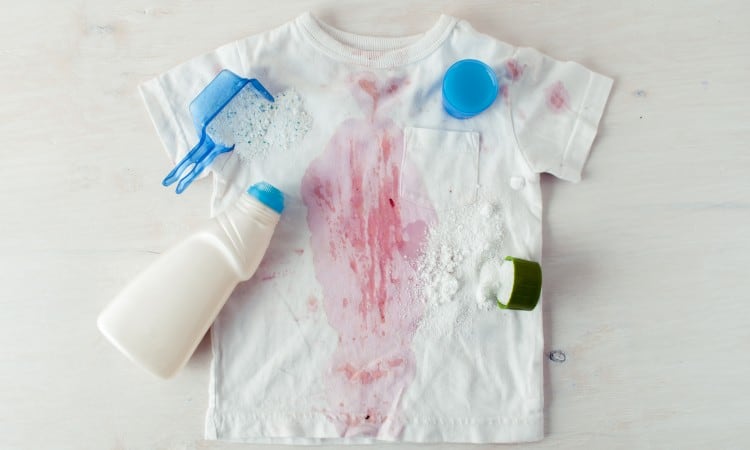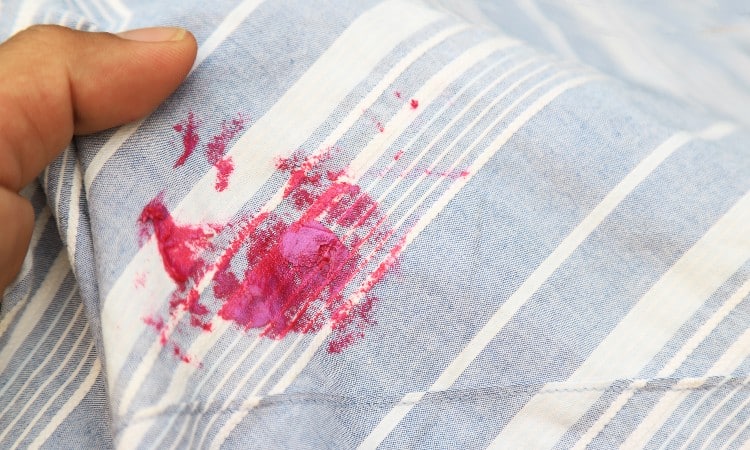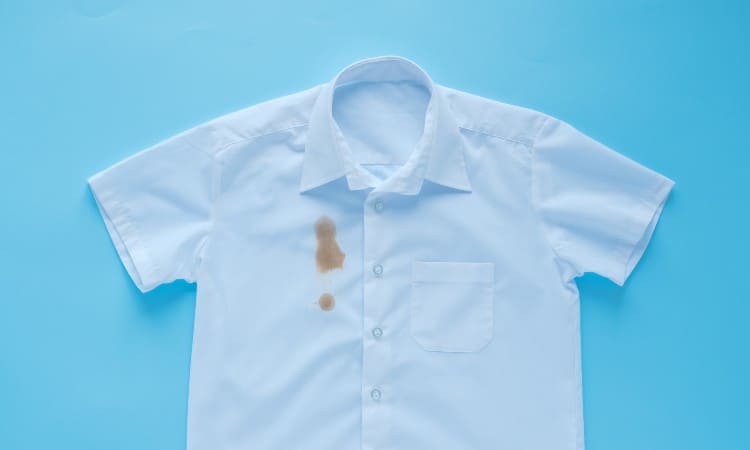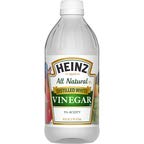Have you ever struggled to eat a piece of frosted cake on one of those flimsy paper party plates? One time, I flipped the entire piece of cake icing-side down onto my dress, right in front of the whole party! I survived that embarrassing moment, but I had icing all over my dress and had to wonder, does food coloring stain clothes?
Food coloring does stain clothing, but several treatments can remove the stain before it becomes permanent. Household products such as vinegar, dish soap, hydrogen peroxide, and rubbing alcohol can lift the color out of fabric. Soaking stained clothes in oxygen bleach can remove stubborn food coloring stains.
In this article, you’ll learn how food coloring works and what can make it permanent in fabric. You’ll also find five easy methods for stain removal. Finally, you’ll discover tips for getting food dyes out of non-washable clothing.

Does Food Coloring Stain Clothes?
Food coloring will almost always stain your clothes on contact because it is designed to transfer highly condensed color very easily. That said, different kinds of cloth react in unique ways to these coloring agents. For instance, synthetics like polyester will resist stains more easily than natural materials like cotton.
Most artificial food dye contains synthetic material derived from petroleum and a variety of condensed coloring agents. These range from ground-up insects to certain bacterias, as well as plant-derived dyes like indigo.
When the first synthetic (man-made) food dyes appeared on the scene, manufacturers made them using something called coal tar as the base for the dyes! Today they have an oil base made from petroleum.
This may sound gross to you. In fact, for the past fifty years or so scientists and health experts have held many debates over the safety of several kinds of food coloring. Despite this, manufacturers and consumers continue to love the bold, appealing color produced by these artificial dyes.
You can find or create your own all-natural additives using items like turmeric to create a yellow tinge or beets for a pinkish hue. However, the food coloring you buy from stores is almost always artificial and typically comes from liquid, gel, or powder.
Technically, this food additive is a type of acid dye. These kinds of dye have a type of acid in their molecular structure but have no caustic properties. You can even safely ingest them in the case of food colorings! Textile designers use acid dyes to color protein-based fibers such as wool, silk, and feathers.
Is Food Coloring Permanent On Fabric?

Food coloring will stain fabric, but in most cases, you can easily wash away the color. It will not permanently dye cotton or most synthetic materials. That said, with proper treatment you can make it color-fast in certain animal fibers like wool or silk.
To make acid dye color-fast and wash-fast, you have to create a dye bath using powdered dye, very hot water, and white vinegar. These elements allow the color to bond with the proteins in protein fiber materials.
Assuming you have not boiled your stained clothing in water and white vinegar, the color should not set permanently even if your toddler smeared red Jell-o all over your favorite wool sweater. You simply need to follow the right steps to get the food dye out of the material.
Of course, as with any stain, prompt treatment is your best guarantee for successful removal! Old food coloring stains may take time and some elbow grease. Fresh stains come off much more easily!
How to Get Food Coloring Out of Clothes: 5 Easy Methods

Let’s get down to the nitty-gritty of the five easy, safe ways you can get food coloring out of clothes! You probably have most of these common household products already on hand. If not, most of them cost less than five dollars at your local Walmart or grocery store.
This means you can simply select which method looks most convenient and get rid of that colorful stain!
You will find the process super simple if you prep all the items you need and get them together in a splash-safe work area like your kitchen or bathroom.
Also, please note that some of these methods work best on certain types of cloth. If in doubt, you can always test a few drops of a cleaning product on an inconspicuous area of your garment to make sure the fabric doesn’t have a bad reaction.
Pretreat
All of the five methods described here work best if you follow these pretreatment tips.
First, blot or scrape any liquid or particles that remain on your clothing. You need to remove food or dried-on gunk before you can even really see the stain!
For example, if you have a blob of neon green cake icing on your white blouse, carefully lift away the blob using a knife. If your little one spilled Hawaiian punch all over his best outfit, blot up as much moisture as possible with a paper towel or clean white rag before you begin.
Whenever you’re dealing with a wet stain, you should try to blot or dab at it with a cloth instead of rubbing it. You don’t want to rub at a stain because this will just smear it into a bigger, more unruly mess.
Second, consider using an enzyme-based stain remover designed to disintegrate the stain for serious or older stains. If you apply the remover and wait fifteen minutes, you will save yourself a lot of hassle!
Finally, you should turn your garment inside out for all food coloring stains and run cold water through the stain from the back of the fabric. This will encourage color to fall away from the fabric instead of getting swished more deeply into the fibers.
1. Vinegar and Dishwashing Soap
 Vinegar does a great job lifting all sorts of stains from clothing. With the help of a little dishwashing detergent for good measure, it will almost certainly get the last vestiges of stains from clothing.
Vinegar does a great job lifting all sorts of stains from clothing. With the help of a little dishwashing detergent for good measure, it will almost certainly get the last vestiges of stains from clothing.
1. Dampen a clean white cloth or sturdy paper towel and hold it against the stain. You want to press firmly, but don’t rub!
2. Check to see if any color came away on your paper towel. If it did, repeat this process with a new towel or rag until you no longer see the color coming away.
3. Next, set up a shallow dish like a baking tray and measure in one cup of cold water, one tablespoon of white vinegar, and one teaspoon of dishwashing detergent. Swish this around a bit with your fingers to mix it all.
4. Submerge the stained area completely in this mixture and let it rest for fifteen minutes.
5. Lift the garment away from the solution and rinse it under cold running water. Make sure you hold the stained area, so the water flows from the back of the fabric to the front.
6. Finally, hold the garment up to the light to see if any stain remains!
If you’re happy with the color-free garment, go ahead and throw it in your washing machine. If not, repeat the vinegar soak.
Vinegar has a natural acidity that helps it dissolve many kinds of stains. This works especially well on stains that also have some acidity, such as sweat or food dyes!
Plus, you can apply vinegar to most fabrics without risking any damage.
2. Hydrogen Peroxide
 You likely have a bottle of hydrogen peroxide in your medicine cabinet in case of any cuts or scrapes that need disinfecting. Hydrogen peroxide can also serve as a teeth whitening agent, sponge sanitizer, and stain remover!
You likely have a bottle of hydrogen peroxide in your medicine cabinet in case of any cuts or scrapes that need disinfecting. Hydrogen peroxide can also serve as a teeth whitening agent, sponge sanitizer, and stain remover!
As a note of caution, hydrogen peroxide may discolor black clothing. This is a product you should test in a hidden area of your garment before applying as a stain remover.
1. Perform thorough blotting on any still-damp stains. Repeat the blotting until you no longer see any color smearing off onto your clean white cloth or paper towel.
2. Fill a shallow dish like a baking tray or pie pan with a cup of cool water, a tablespoon of hydrogen peroxide, and a teaspoon of dishwashing detergent.
3. Settle the stained area into this solution and let it soak for 15 minutes to 30 minutes.
4. Immediately rinse the stained area under running water. Make sure you turn the material over so the water runs through from the back of the stain.
5. Examine the damaged area closely to see if any stain remains. If everything looks good, throw the garment in the washing machine with your regular laundry detergent!
6. If any color remains, try repeating the soaking process.
Hydrogen peroxide has a cool ability to oxidize and break down the color chlorophyll in stains. Oxygen bleach contains a large percentage of hydrogen peroxide, which explains why this product can also discolor some kind of material.
3. Rubbing Alcohol
 Rubbing alcohol is another handy natural stain remover often stashed somewhere around the house! If you’ve ever made a fun tie-dye craft using sharpies and rubbing alcohol to spread the ink into fun patterns, you know how easily the alcohol can dissolve and move through color.
Rubbing alcohol is another handy natural stain remover often stashed somewhere around the house! If you’ve ever made a fun tie-dye craft using sharpies and rubbing alcohol to spread the ink into fun patterns, you know how easily the alcohol can dissolve and move through color.
1. For this method, use a damp cloth or paper towel to remove as much color as possible first.
2. If the stain persists, get out a liquid measuring cup. Measure in two tablespoons of alcohol, one cup of water, and a small squirt of dishwashing detergent.
3. Stir this up just a bit till the dish soap dissolves.
4. Take a clean sponge and soak it in your solution. Use a careful blotting motion to clean the stained area using the damp sponge.
5. Rinse the clothing under running water from the back of the stain. Don’t be afraid to keep the stain under running water for a minute or so as your rinse, as this provides the final cleaning stage and carries away any remaining color.
6. Check it out–is the stain gone?
7. If so, wash your clothing as usual!
The nice thing about this method, besides its general effectiveness, is that it applies the cleaning solution to a sponge instead of directly to the clothes. This gives you a little more control and offers less risk to the material of your clothes as you remove stains.
4. Oxygen Bleach
 You may rightly hesitate to use bleach on your favorite clothes because it can harm certain types of fabrics. You should never use bleach on silk or wool, for example. That said, most fabrics can handle carefully diluted oxygen bleach without any dire consequences.
You may rightly hesitate to use bleach on your favorite clothes because it can harm certain types of fabrics. You should never use bleach on silk or wool, for example. That said, most fabrics can handle carefully diluted oxygen bleach without any dire consequences.
Chlorine bleach, on the other hand, has far greater strength and can harm some kinds of cloth. Chlorine bleach can damage synthetics like polyester and can eat through other materials, even denim, over time! For this reason, you should try oxygen bleach instead.
You should test a drop of the bleach and water solution on a hidden corner of your clothes before trying this method, though.
Also, take precautions such as working in a well-ventilated area, wearing rubber gloves, and putting down plastic trash bags as splash protection before using bleach.
1. Set up a large bucket, basin, sink, or bathtub that you won’t need for the next ten hours. Fill it with warm water.
2. You can use either liquid or powdered oxygen bleach. Read the package to find out how much to measure based on the gallons of water you used.
3. Allow the bleach to dissolve before adding your stained garment. Use rubber gloves to fully submerge the garment in the solution.
4. Allow the garment to soak for eight to ten hours.
5. Carefully rinse it out and then transfer it to your washing machine.
6. Run your normal laundry cycle using cool water to remove the bleach.
Oxygen bleach isn’t as strong or dangerous as chlorine bleach, but this should still be reserved as a last-ditch effort at stain removal. For one thing, it takes a long time. For another, it’s always a good idea to try a mild cleaner before moving on to the nuclear option of cleaning products!
5. Ammonia
 Like bleach, ammonia has powerful cleaning abilities but comes with some disadvantages as well.
Like bleach, ammonia has powerful cleaning abilities but comes with some disadvantages as well.
Ammonia has a strong scent and can irritate your skin. Make sure you use all necessary caution, such as wearing gloves while working with this product. You should also avoid using it with wool, silk, or nylon.
That said, it does an excellent job removing troublesome stains, especially grease stains that some stain removers won’t budge.
1. Set up a well-ventilated area with a bucket or bowl that can hold your stained clothing.
2. Measure in a quart of cool water, a tiny squirt of dish soap, and one tablespoon of ammonia.
3. Add the stained garment and let soak for 15 to 30 minutes.
4. Rinse out the garment. If you still see lingering dyes, go on to the next step.
5. Empty the bucket and refill it with one quart of water and a splash of vinegar.
6. Soak the garment again for up to 30 minutes.
7. Then wash your clothing as usual.
This method does take a little more effort, but it even works on stubborn red food dye stains!
Finally, please note that you should never mix ammonia with bleach! This could cause a very dangerous reaction.
How to Get Food Coloring Out of Non-Washable Clothes
The best way to get food coloring stains out of dry clean or non-washable clothes is to use water or water and vinegar. If this method would damage the garment, you should take it to a professional dry cleaner.
You can easily find care directions for your clothes on the manufacturer’s label inside. This tag should indicate if the item is dry clean only or if you can safely wash it at home.
Sometimes you can safely spot-clean non-washable garments even though you should not submerge them in water. Simply test a tiny dab of water on a hidden area of the clothing. Let it dry, and check to see if the water caused any damage.
Alternatively, you can add a cupful of vinegar to a cup of water and use that solution. This tends to work well on white clothes.
- To spot clean, lay your garment out on a clean towel.
- Dip a sponge or cotton ball (depending on the size of the stain) into the cool water.
- Dab gently at the stain until it loosens, dissolves, or fades.
- Frequently rinse the sponge or replace the cotton ball so you don’t end up returning the color to the original stain!
If you do need to pay for a professional dry cleaner, do your best to remove any particles or dampness from the stained area first. Then explain what happened and what kind of product made the stain to the dry cleaner. Finally, make sure you indicate the stain on the garment.
At that point, the dry cleaner should let you know if they can treat the stain or not.
Can You Use Food Coloring to Tie-Dye?
You can use food coloring to tie-dye, but it will not set permanently in most fabrics. Despite that, it offers a fun and less risky option for crafting with kids. You can also follow the necessary steps for creating an acid dye bath if you want to make these dyes color-fast in cloth like wool and silk.
You can create a fun tie-dye project using these steps and any material except cotton or linen.
- Set up a clean sink or large bucket. Mix equal amounts of water and vinegar.
- Soak your shirt, socks, or scarf in this solution for an hour.
- Next, set up plastic solo cups half-full of warm water. Get as many cups as the number of colors you plan to use.
- Drip eight drops of liquid coloring into each of the cups.
- Next, either scrunch up handfuls of your material in rubber bands or bunch up the whole item on top of a wire rack with ice cubes on top of it.
- Then fill medicine droppers or pipettes with the colors of your choice, and drip them over the white material!
- Let everything sit for at least eight hours or overnight.
- Rinse in a solution of equal parts and water until the water runs clear.
- Wash the item by itself in your washing machine.
You probably don’t want to throw the tie-dyed item in with any other clothes in the laundry. As you now know, this dye job isn’t exactly permanent. That said, it’s fun while it lasts!
Can You Get Food Coloring Out of Carpet and Upholstery?
Most of the time you can get food coloring out of your carpet and upholstery using the vinegar method described earlier. This depends on the materials involved, though. For example, you should never apply water or cleaning products to silk upholstery–leave that to the professionals!
Usually, though, you can use the vinegar and soap method described earlier, with a few variations.
- First, do your best to remove any solid remnants like icing, ice cream, jello, and so on.
- Next, combine a tablespoon of vinegar and dish soap with two cups of warm water. Stir it.
- Dip a clean microfiber cloth in this solution.
- Blot the stain with the microfiber cloth.
- Let the stain sit for 30 minutes, and then repeat the blotting process.
- If any stain remains, get a clean sponge and a cup of cool water. Sponge the stain with the water.
- Next, try sponging with rubbing alcohol.
- Finally, sponge with water again and let the area dry.
As you go through this process, make sure you check your cloth frequently and rinse it out as it accumulates color.
Conclusion
Food coloring stains in clothes may look terrible, but you can usually remove them with a few simple methods. Common household products like vinegar and dish soap, hydrogen peroxide, and rubbing alcohol will often remove these stains. For more serious issues, you can apply oxygen bleach or ammonia.
Most of the time, you can also easily blot stains on carpet and upholstery using vinegar and soap.
Have you ever encountered a dreadful food dye stain? How did you get it out of your clothes? Leave a comment below to let us know!